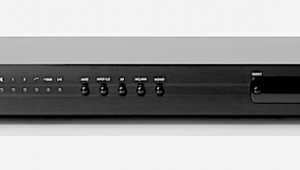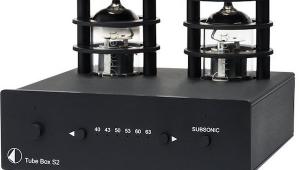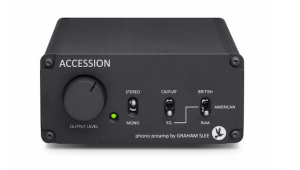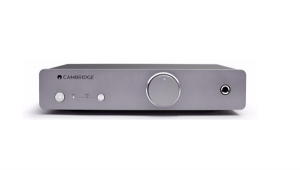The low noise, superb linearity, and excellent channel separation are definitely positive aspects. However, the concern about the low overload margin at 20kHz and above is something to consider, especially for use with certain phono cartridges. It's interesting to note the discrepancy in RIAA equalization between the channels, as highlighted in the measurements time calculator
Simaudio Moon LP5.3 phono preamplifier Measurements
In the March 2007 Stereophile, Michael Fremer devoted part of his "Analog Corner" column to a rave review of the Moon LP5.3 phono stage ($1400) from Canadian manufacturer Simaudio. "Out of the box, the LP5.3 proved quiet and sweet-sounding, with bass that was well-controlled, tuneful, and rhythmically solid, a harmonically rich midband, and a somewhat closed-in top end," he wrote. "The LP5.3's macrodynamics lacked the exuberance of the finest phono stages I've heard, but thanks to its impressively low noise, the 5.3's nuanced microdynamic shadings—the kind that contribute to 'believability'—helped create a consistently engaging sonic picture."
I had seen a prototype of the LP5.3 when I visited Simaudio's headquarters just south of Montreal in the summer of 2006, so after reading Mikey's very positive comments, I asked Simaudio for a sample to run through my measurement mill.
The LP5.3's circuitry is based on two lead-free, surface-mounted printed circuit boards separated by a metal partition, one with the power supply, one with the audio circuitry. The latter has local voltage regulation and each channel is based on premium Analog Devices OP97 and Burr-Brown OPA227 precision op-amp chips, and a very low-noise Burr-Brown INA163 instrumentation amplifier, this often found in microphone preamplifiers.
The Moon phono preamp has both single-ended outputs (on RCA jacks) and balanced outputs (on XLRs). I performed most of my measurements from the XLR jacks, and with the internal loading and gain circuit-board jumpers set to an input impedance of 47k ohms in parallel with 0pF capacitance and 40dB gain.
The LP5.3 offers four different gain settings: 40, 54, 60, and 66dB. The measured gains from the unbalanced jacks were very close to those specifications, at 40.2, 54.7, 59.9, and 65.4dB, respectively. As expected, the balanced output was 6dB higher in each case. Both unbalanced and balanced outputs preserved absolute polarity; ie, were non-inverting. (The XLRs are wired with pin 2 hot.) As Mikey found, the LP5.3 was very quiet, with a measured wideband signal/noise ratio of 85dB, this improving to 93.7dB when A-weighted. These figures were ref. 1kHz input at 5mV with the preamp set to 40dB of gain. Changing the gain to 60dB worsened these figures to 68 and 76.6dB, respectively, but this is still excellent performance. Channel separation was excellent, at better than 100dB in the treble. DC offset on the unbalanced outputs was negligible at –0.4mV left and –0.5mV right.
The output impedance was a uniform 100 ohms balanced and 50 ohms unbalanced across the audioband. The input impedances (at 1kHz) measured very close to specification: 44.1k ohms ("47k"), 967 ohms ("1000"), 469 ohms ("470"), 100 ohms ("100"), and 10.3 ohms ("10").
Using more internal jumpers on the audio circuit board, the user can select either traditional RIAA equalization or the IEC-modified curve, which rolls off the low bass to reduce the impact of record warps. The departure from accurate equalization is shown in fig.1. The bottom pair of traces below 200Hz show the effect of the IEC modification: the bass gently rolls off, reaching –1dB at 40Hz and –3dB at 20Hz. Without the IEC EQ selected (top pair of traces below 200Hz), the low frequencies are flat down to the 10Hz limit of this graph. The error is low in absolute terms, at –0.05dB left, –0.1dB right, +0.26dB left, and +0.75dB right. However, both the mismatch between channels above 1kHz and the shape of the error curve are disappointing. While the boost in the treble may be slight, it covers a wide enough range to be audible.

Fig.1 Simaudio Moon LP5.3, phono-stage RIAA error at 5mV input at 1kHz (0.5dB/vertical div., right channel dashed).
I was puzzled, therefore, to read that Michael had found the LP5.3's treble to sound a little recessed: "Over time, the top opened up nicely; though I wouldn't say it ever became particularly airy or fast, I'd take the 5.3's top-end performance over the aggressive, etchy, and wiry variety every time. I don't mean to imply that the 5.3 sounded dull or sluggish—anything but." It's possible, of course, that the moving-coil phono cartridge MF was using for his evaluation had the mid-treble depression typical of MC designs, in which case the combination of cartridge and preamp would have produced a neutral-sounding balance.
With the preamp set to 40dB gain, the overload margin at low and middle frequencies was excellent, at 22–23dB ref. 1kHz at 5mV. However, the overload margin was just 2.2dB at 20kHz, which is very disappointing. Changing to 60dB gain, the picture remained unchanged: 22–23dB margin at low and middle frequencies, but just 2.9dB at 20kHz. Fortunately, LPs rarely have high levels of musical energy above 10kHz, but the Moon preamp might emphasize the sound of surface ticks. Usually, a low overload margin at 20kHz leads me to suggest that the preamp's owner set the gain at the lowest possible for a given cartridge—something that can be done with impunity given the LP5.3's own low noise level—but the fact that the margin at 20kHz doesn't improve with the lowest gain setting works against this fix.
On a more positive note, provided the signal was below the clipping point, the Moon LP5.3 offered extremely low levels of distortion and noise. Fig.2, for example, shows the spectrum of the unbalanced output with the preamp set to 40dB gain, driving a 1kHz tone at 1V into 8k ohms. All the distortion harmonics are at or below the noise floor, and the actual level of THD (true RMS sum of the harmonics) was 0.0008% left and 0.001% right.

Fig.2 Simaudio Moon LP5.3, spectrum of 1kHz sinewave, DC–10kHz, at 1V into 8k ohms (linear frequency scale).
I normally measure high-frequency intermodulation at an output level of 1V, but the LP5.3's low overload margin at the top of the audioband meant that this wasn't possible, the preamp producing a very high level of difference product (2.5%). Reducing the output level to 700mV dropped this to 0.1%; fig.3 shows the spectrum of the LP5.3's output as it reproduced a mix of 19kHz and 20kHz tones at a peak level of 600mV into 8k ohms. The difference product now lies at a respectably low 0.013% left and 0.009% right; the only other intermodulation components visible above the noise floor, at 18kHz and 21kHz, lie at –100dB, which is negligible.

Fig.3 Simaudio Moon LP5.3, HF intermodulation spectrum, DC–24kHz, 19+20kHz at 600mV peak into 8k ohms (linear frequency scale).
In many ways—very low noise, superb linearity, excellent channel separation—Simaudio's Moon LP5.3 offers measured performance that is beyond reproach. The departure from strict RIAA equalization accuracy will also not be an issue with typical moving-coil cartridges, with their swaybacked treble response. And its construction quality and wide range of user adjustments are commendable. But that very limited high-frequency overload margin does concern me; it possibly restricts the LP5.3 to use with phono cartridges that have lower-than-normal output levels. Fortunately, the preamp's low levels of noise make this possible.—John Atkinson
- Log in or register to post comments



















































